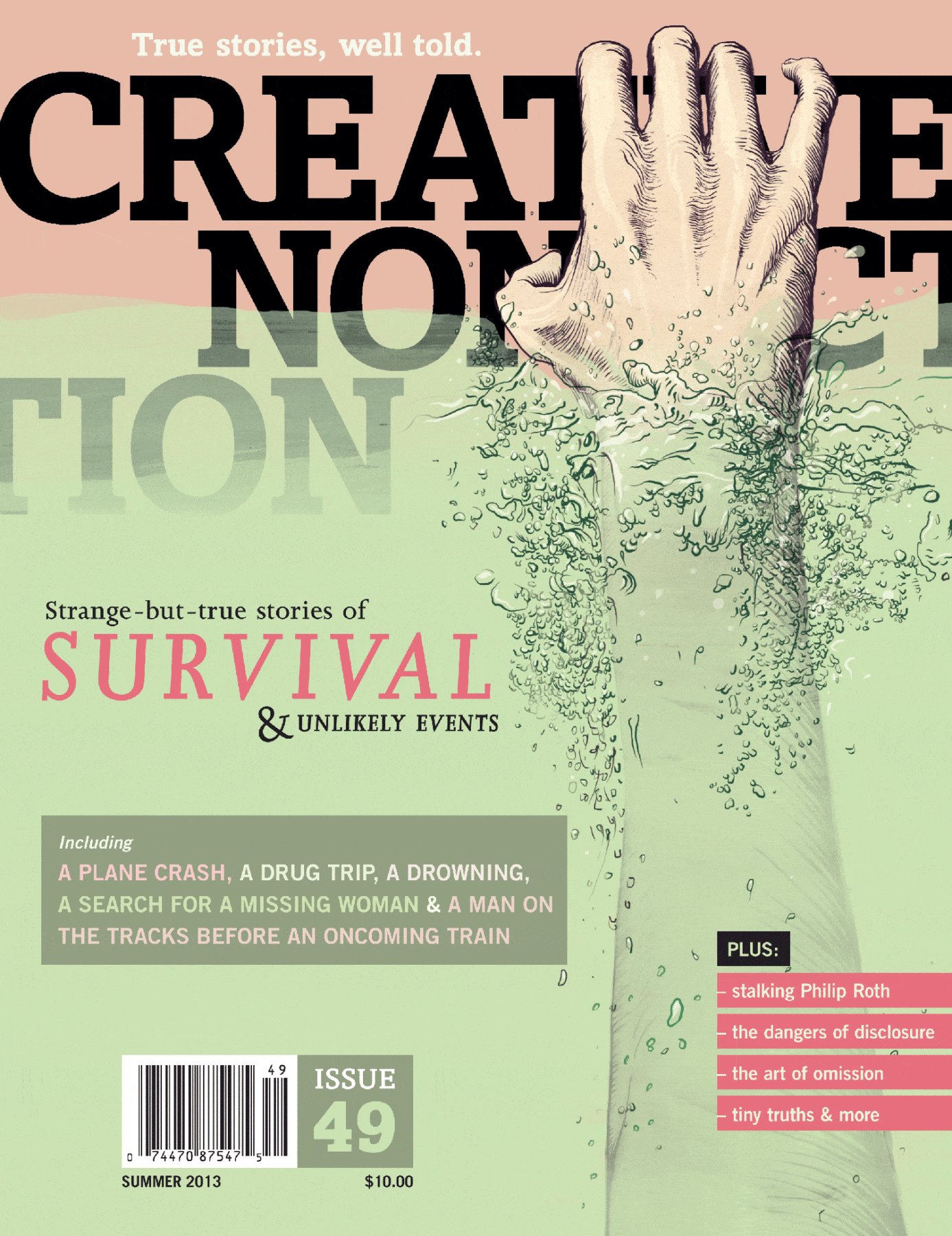Issue 49 / Summer 2013

49 / Survival Stories
Strange-but-true stories of near misses
Issue #49 is devoted to hair-raising stories of near misses. Writers reflect on narrow escapes from a plane crash, youthful recklessness, and a train barreling down on the station.
The rest of the issue is a writer’s survival guide, with notes on making dialogue work, a love letter to literary letters, Roxane Gay on the dangers of disclosure, and a visual guide to the personal essay. Plus, we’re stalking Philip Roth.
Already a subscriber?
Read this issue nowTable of Contents
What’s the Story #49
"Telling stories is how we try to make sense of otherwise inexplicable events."Picturing the Personal Essay: A Visual Guide
A design professor from Denmark once drew for me a picture of the creative process, which had been the subject of his doctoral dissertation. “Here,” he said. “This is what it looks like”: Aha, I thought, as we discussed parallels in the writing process.The Saltwater Twin
An imaginary mythical creature becomes a way to escape the undercurrents of family abuseWhy I Remembered What I Remembered
This is how I remember it: My father had taken us along on a business trip to Florida that summer, and we had stayed on through the Fourth of July weekend, driving a rental car down the length of the state.The Hippest Bar on Christmas
Fifteen years ago, I went to a Christmas Eve party that ended early. A couple of guys invited me to the only tavern open in Iowa City, and I joined them.Man on the Tracks
"When you watch a man on the tracks before an oncoming train, that’s exactly what you do: watch."Locked Out
Summer didn’t let us down easy this year. By the time October was turning orange, the island had already been through sickness, betrayal, abandonment, dementia, and a couple of deaths. Some losses are expected, the inevitable bereavements we steel ourselves for: The elderly man who took leave of his mind and then, a few months later, his body.White-Space Memoirs: The Power of Artful Dodging
What you put in. What you leave out. It all comes down to this—and the leaving out is the hardest part, the heart of the art that is memoir. Autobiography is what happened first, what happened next, what happened then; it is bricks and mortar.The Spoken Word, Distilled: Notes on Philip Roth, Bernard Cooper, and crafting compelling dialogue
Who doesn’t like to eavesdrop? Riding the subway, standing in line at the bank, sitting at a restaurant table conveniently close to another table—all of these provide opportunities to drop in on a stranger’s life.Writers, Be Kind!
In March, I reviewed William Dalrymple’s Return of a King: The Battle for Afghanistan, 1839-1842, for The Christian Science Monitor. Though I knew little about colonial Afghanistan, I didn’t hesitate to take the assignment.Literary Letters: Correspondence as Art
Until his death on January 27, 2010, J. D. Salinger was famously a recluse. Once a darling of the New York literary scene, he had published nothing since 1965, though there were rumors that he wrote every day.The Danger of Disclosure
I have been online, in one way or another, since the early 1990s. In the early days, I was on a desktop computer, a Macintosh LC II, with a very slow modem.No One Lives Here
We’re sorry; we’re currently unable to make this work available online.Zuckerman Found
I’m stalking Philip Roth. OK, maybe stalking overstates it—I haven’t crosshaired him through a scope—but I’m definitely creeping and staring, prowling like a borderline case with a hunting wound. Since I spotted America’s Greatest Living ex-Novelist crossing Seventy-Ninth Street, I’ve been bloodhounding him around the Upper West Side.Finding Fragments in Details
"Sometimes it's a challenge not to be too precious about your own ideas. Working with editors and art directors makes the process more of a group effort—you’re working towards a harmonious whole."
